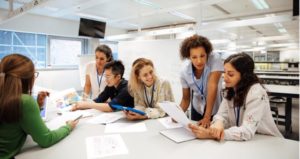
When Everything Goes Right in the Classroom
It is difficult to predict what the dynamics of a college class will be like at the beginning of a semester. Two sections of the

It is difficult to predict what the dynamics of a college class will be like at the beginning of a semester. Two sections of the

Inclusive teaching involves creating equitable and welcoming educational environments for the diverse learners in our classrooms. Such approaches may involve, but are not limited to:

Igniting an emotional connection to content inside the classroom can be a powerful tool for student retention, but intertwining technology and emotion in the classroom

There has been a long discussion within our college about whether or not teaching to the test is appropriate. Of course, the test that we

Over the years, I’ve had the pleasure of working with approximately 300 faculty who have developed and taught their first online course. One of the

An initial look at a conference program can lead attendees to become (in the words of a former colleague) “paralyzed by the possibilities.” There are

After a fifteen-year hiatus from teaching musicianship classes (I typically teach undergraduate music theory core classes and graduate classes), I taught Musicianship 1 last semester

Participating in team projects offers students the chance to develop interpersonal communication skills (Figueira & Leal, 2013), build relationships with classmates, and increase the level

In the world of diets, movements are the thing that sells…Vegan, Paleo, Whole 30, Keto, and, now, Carnivore (…seriously, it’s a thing). Yet, upon closer inspection, many of these diets perform similarly in the long run, which is to say they perform underwhelmingly. When a dieter fails to get the pseudoscientific benefits promised, they are likely to blame themselves. They relapsed, cheated, or otherwise failed to follow instructions (succumbing to the fate of being an imperfect human being). It is less likely that we question the diet. Instagram before and after posts abound. Diets can put people in a bind: why won’t this work for me? Given the gap between basic principles (eat your vegetables, less processed foods) and the dos and don’ts of diets, it’s worth asking what value diets add to our lives.

Because I teach mixed demographic courses, I often look out at a sea of distracted and unmotivated faces. Motivation is a large part of learning (Pintrich and deGroot, 2003). So, I use active learning activities, such as think-pair-share, to not only motivate students (Marbach-Ad et al., 2001), but also to enhance student learning (Bonwell and Eison, 1919; Freeman et al., 2014). If I’m being honest, active learning also has the added perk of distracting students from the monotony of my voice. Yet, in the past few years, I have begun to wonder if I have taken it too far? Am I simply using active learning as a way of keeping bored students active?
Get exclusive access to programs, reports, podcast episodes, articles, and more!